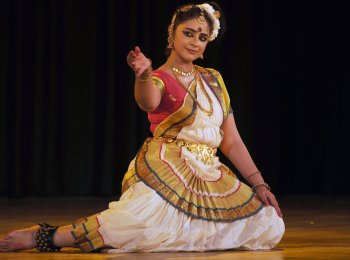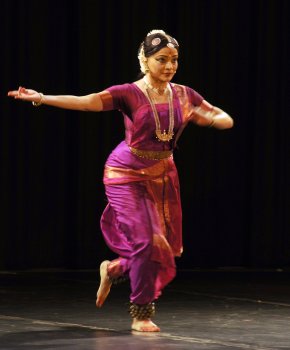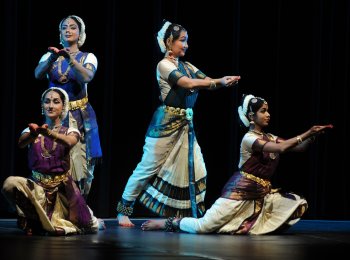 |
 |
Madras Music Academy dance festival: Day 2 - Veejay Sai e-mail: vs.veejaysai@gmail.com Photos courtesy: Madras Music Academy January 12, 2013 Ganesha’s frog and other stories  The first day’s morning shows opened with a solo Bharatanatyam recital by Sumithra Subramaniam, the daughter of the famous Jayanthi Subramaniam, who at one point ruled the scene and the stage. Sumithra opened her performance with an invocation to Lord Ganesha, setting to tune Adi Shankara’s famous composition the ‘Ganesha Pancharatnam’ composed in a Ragamalika. While a large part of her abhinaya was repetitive with the same mudras and stances she took, the ending came with an unexpected entry. As Ganesha left the stage, the rat, or mooshika leaped and jumped its way out. For a second everyone thought it was a very devoted frog chasing the elephant god. Performing the famous Varnam ‘Samiyai vara cholladi’ composed by K N Dhandayudhapani Pillai set to Purvi Kalyani ragam, Sumithra was at her mechanical best. Clean lines and good nritta shone in patches. The melodious flute prelude that J B Sruthi Sagar gave before the Varnam began was a saving grace. Sruthi Sagar’s flute and Kalaiarasan’s violin shone through and through. In the famous Jayadeva Ashtapadi ‘Sakhi hey,’ Sumithra displayed average abhinaya. Nowhere was the character of the nayika established satisfyingly. While Radha Badri has a melodious voice and sings good Tamil and Sanskrit songs, she has problems with her Telugu diction. Often distorting the sahityam, she waded her way through Patthabhiramayya’s javali ‘Enthati Kuluke’ set to ragam Kalyani. Sumithra concluded her performance with a Thillana in ragam Suruti. She needs a lot more polishing in her footwork and abhinaya. Mid-morning enchantress  The only solo Mohiniattam performance for this season’s festival went to the well-spoken Methil Devika, who began her performance with an invocation in Ragamalika and Talamalika. A composition of Maharaja Kartika Thirunal Balarama Varma, this composition has numerous intricate patterns within it for the dancer to explore. Devika’s dance came out well and kept the audience interested in it from the beginning, but Baiju’s veena was drowned out by the loud percussion. The ending of this seemed a bit weird with Devika just walking off the stage saying something, even as the talam continued. The second piece she performed was a theme-based one called ‘Amman Katha,’ a composition of the legendary scholar Kavalam Narayana Panikker. This story seems very close to that of Kannagi and Silapathikaram; this one has its roots in Kerala. The sthala puranam of Kodungallur Bhagawathy or Amman in Thrissur district of Kerala is a lesser known one when compared to the Silapathikaram. This epic is still celebrated widely with the temple festival and rituals there. It took a visionary like Panikker to devise this story for dance. Set to the Panchari talam, a variant of the Roopakam, Devika opened with the scene of the couple taking marriage vows and continued to narrate the whole tale efficiently portraying the anguish of an unfulfilled wife. Baiju’s Vasanta ragam aalapana on veena was noteworthy, but Devika’s dance lacked the pathos one needed to describe the scene. The transition from Kannagi to Amman was too quick and the story also paced at an unnecessary speed. If only Devika had taken enough time to do this piece, it would have stood out as one of the finest items performed ever in Mohiniattam on the prestigious academy stage. The third item she presented was the story of a nayika after a night long passionate affair. The sancharis were woven cleverly into a Narayana Theertha Tarangam. The composition was set to Chamba talam. According to the narrative, it seemed almost dramatized when Devika’s bindi fell off her face and she continued dancing and smartly employed movements to stick it back on her forehead. Soorya Narayanan’s flute was exceptional. Methil Devika is a thinking dancer and knows to do justice to her performances, unlike many other Mohiniattam performers. The magic of Malavika  She came, she danced and she conquered. Malavika Sarukkai’s performance at the Music Academy went beyond the usual and beyond everyone’s expectations. Watching her perform this season shattered many a rumour that she was lost to the traditional margam. Malavika opened her performance with a pushpanjali and continued into a thevaram by Appar set to Ghambira Nattai. Invoking the auspicious energies on stage, she was all set to give a storm of a show. The first thing one noticed from her very entry as she began performing was her lovely braid. The jadai that went missing for so many years made a significant comeback almost like a special effect to the nayika she portrayed in the Varnam that followed. Performing the classic Thanjavur quartet varnam ‘Sami ninne korinanura’, one wouldn’t have expected any other dancer to stick close to the original Thanjavur baani’s version of rendering this. Standing at the edges of her feet, almost like a ballerina on the tip of her toes, Malavika showed us all the procession of Lord Shiva that the nayika was peeping at. She gave her full in each and every aspect to the Varnam’s demand. Continuing into the famous Pattabhiramayya javali in ragam Purvi Kalyani ‘Nee maatalemayenura’, once again it was a sight to see Malavika’s creativity in the conversation that the nayika has with the parrot. With some excellent mridangam support by Nellai A Balaji, she choreographed this javali using various time-tested techniques of abhinaya to the mridangam’s beats. The third item she presented was inspired by a poem by her sister, the well known poet Priya Sarukkai Chhabria. Set to ragam Brindavana Saranga and adi talam, this piece showed the flight of a bird as it sweeps over the city of Kashi and observes the pilgrims. After a Thillana in Hamir Kalyani composed by B V Raman and B V Lakshmanan (two names that only bring in nostalgia to the world of music and dance), Malavika finished her recital with a sweet and short choreography of ‘Vande Mataram’ increasing the patriotic fervor of the hall full of rasikas. Malavika’s performance this season put an end to all the debate and dialogue everyone has been having about her. She proved once again that she can do the traditional when needed and delineate into her own creative abilities when required. Vempati’s artistic successor  In the last couple of years, if there was any one state in India that saw a steep decline in its cultural graph, it was Andhra Pradesh. With the demise of three of its most popular and world famous cultural ambassadors of dance - Nataraja Ramakrishna, Vempati Chinna Satyam and Vedantam Satyanarayana Sharma - Andhra Pradesh became poorer. It was already a State on the verge of collapse with most of its cultural practitioners fleeing due to severe disregard to the artiste community. The one who sensed this long ago was Guru Vempati Chinna Satyam who made Chennai his home for the rest of his life. Having groomed countless students, Vempati left behind an undeniable legacy unlike no other Kuchipudi guru. It is from this rich legacy that Jaikishore Mosalikanti hails from. Thank god, the Madras Music Academy decided to have at least one Kuchipudi performance this festival. As the lines ‘Gurum tamo haram, sakala gyaana karam’ opened the show, Jaikishore’s well-executed choreographic talent came across as impressive. Composed as a tribute to guru Vempati by scholar and expert commentator Dr. Pappu Venugopal Rao, this Pushpanjali showed snippets from the guru’s life and art. From conducting their daily classes to constantly correcting each and every student to perfection, this seemed like an excellent tribute to the great maestro whose portrait adorned the stage corner. While Jaikishore’s visualization was refreshing, what shone through was the vidwat of Dr. Pappu Venugopal Rao. Kishore’s solo in Tyagaraja’s ‘Ksheera sagara shayanam’ reflected Vempati’s choreographic expertise. One must not forget that it was Vempati who first dared to inculcate a lot of Tyagaraja’s kritis, including the famous Pancharatna kritis into the Kuchipudi repertoire. While Kishore was undoubtedly good, it would have been better as a group show. All went well till the veena by T Bhavani Prasad began droning like a guitar, thanks to the over-amplification. The next piece titled ‘Sphoorthi’ or inspiration was the main item for their performance. Opening with a wonderful shlokam, once again a composition of Dr. Pappu Venugopal Rao in ragam Lavangi (a ragam invented by Dr. Mangalampalli Balamurali Krishna), it continued into Dr. Balamurali Krishna’s famous composition on the Devi ‘Amma ananda daayini’ in Ghambira Nattai. With four of the girls in his group, Shobha Korambil, Keiko Watanabe, Padmavani Mosalikanti and Amrita Lahiri, dancing to pure nritta sequences and following it up with the signature Tarangam style on brass plates, this item was a genuine effort being presented with some originality. Though a bit slow and bogged with repetitive sequences, it worked perfectly as a Varnam. Finely executed into a concluding frieze of the various incarnations of the goddess, the Varnam continued into a complicated Thillana in ragam Kalyani, yet another composition of Dr. Balamurali Krishna. Exploring the technique of changing scales within the ragam in Tayamalika style and blending ragas Shankarabharanam, Hindolam, Mohanam and Darbari Kanada and returning into the main body of the composition, this is certainly a challenge for dance choreography. Jaikishore’s choreographic talent came forth in the last two sequences and he proved worthy of being his guru’s ideal shishya. Thanks to artistes like Dr. Balamurali Krishna, dancers like Jaikishore and scholars like Pappu, Andhra cultural scene doesn’t have to hang its head in awkwardness. Veejay Sai is a writer, editor and a culture critic. |